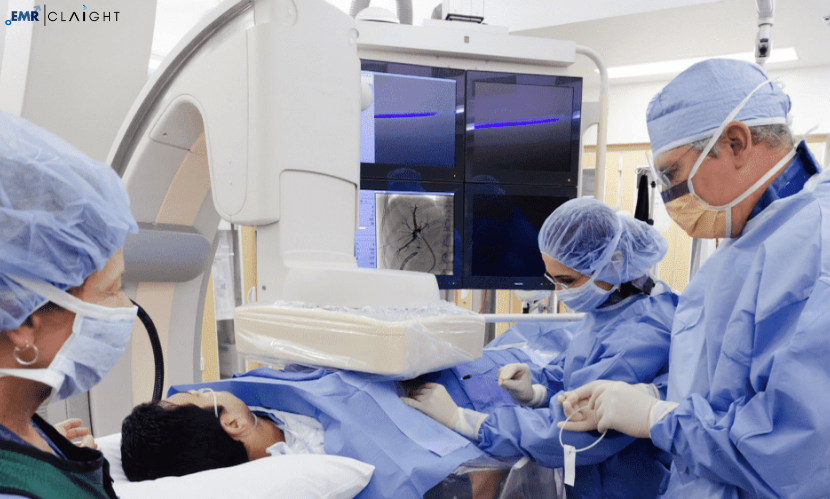The global interventional radiology market size was valued at USD 24.20 billion in 2023, driven by the rising incidence of the geriatric population across the globe. The market is expected to grow at a CAGR of 6.7% during the forecast period of 2024-2032, with the values likely to attain USD 43.37 billion by 2032. This substantial growth underscores the pivotal role of interventional radiology (IR) in modern healthcare, offering minimally invasive diagnostic and therapeutic procedures that enhance patient outcomes and reduce recovery times.
Global Interventional Radiology Market Overview
Interventional radiology is a medical specialty that utilizes imaging technologies such as X-ray, CT, MRI, and ultrasound to guide minimally invasive surgical procedures. These procedures are employed to diagnose and treat a wide range of conditions, including vascular diseases, cancer, and musculoskeletal disorders. The global interventional radiology market has experienced significant growth over the past decade, driven by advancements in imaging technologies, increasing prevalence of chronic diseases, and a growing preference for minimally invasive procedures over traditional surgical methods.
Get a Free Sample Report with Table of Contents: https://www.expertmarketresearch.com/reports/interventional-radiology-market/requestsample
Key Components of Interventional Radiology
- Vascular Interventions: Procedures like angioplasty, stent placement, and embolization used to treat conditions such as atherosclerosis and aneurysms.
- Non-Vascular Interventions: Includes procedures like biopsies, ablations, and drainages used to treat cancers and other non-vascular conditions.
- Minimally Invasive Therapies: Techniques that reduce the need for open surgery, resulting in shorter hospital stays and quicker recovery times.
Technological Advancements
The integration of advanced imaging technologies and the development of sophisticated interventional devices have significantly enhanced the precision and effectiveness of IR procedures. Innovations such as robotic-assisted systems, 3D imaging, and enhanced navigation tools are poised to further propel the market growth by enabling more complex and precise interventions.
Global Interventional Radiology Market Dynamics
Drivers
- Aging Population: The increasing geriatric population is more susceptible to chronic diseases such as cardiovascular disorders, cancer, and diabetes, which require interventional radiology procedures.
- Rise in Chronic Diseases: The prevalence of chronic conditions necessitates minimally invasive treatment options, driving the demand for interventional radiology.
- Technological Innovations: Continuous advancements in imaging and interventional devices enhance procedural outcomes, fostering market growth.
- Preference for Minimally Invasive Procedures: Patients and healthcare providers prefer minimally invasive procedures due to lower risk, reduced recovery time, and minimal scarring.
Restraints
- High Cost of Equipment: The sophisticated imaging and interventional devices are expensive, limiting accessibility, especially in developing regions.
- Lack of Skilled Professionals: There is a shortage of trained interventional radiologists, which hampers market growth.
- Regulatory Challenges: Stringent regulatory requirements for new devices and procedures can delay market entry and increase costs.
Opportunities
- Emerging Markets Expansion: Rapid healthcare infrastructure development in regions like Asia-Pacific and Latin America presents significant growth opportunities.
- Advancements in AI and Machine Learning: Incorporating AI and ML can enhance diagnostic accuracy and procedural efficiency, opening new avenues for market expansion.
- Collaborations and Partnerships: Strategic alliances between healthcare providers, device manufacturers, and technology firms can drive innovation and market penetration.
Threats
- Intense Competition: The presence of numerous players increases competition, potentially leading to price wars and reduced profit margins.
- Economic Uncertainty: Economic downturns can limit healthcare budgets, affecting the adoption of expensive interventional radiology procedures.
- Alternative Therapies: The availability of alternative treatment methods may reduce the demand for interventional radiology.
Global Interventional Radiology Market Trends
Personalized Medicine
The shift towards personalized medicine is influencing interventional radiology by enabling tailored treatment plans based on individual patient profiles. This approach enhances the effectiveness of procedures and improves patient outcomes, driving the adoption of IR techniques.
Integration of Artificial Intelligence
AI and machine learning are being integrated into interventional radiology to enhance image analysis, procedural planning, and real-time decision-making. These technologies improve the accuracy and efficiency of IR procedures, making them more reliable and effective.
Growth of Outpatient Settings
There is a growing trend towards performing interventional radiology procedures in outpatient settings, reducing hospital stays and healthcare costs. This shift is supported by advancements in minimally invasive techniques that allow for quicker recovery and minimal post-procedure care.
Expansion of Robotic-Assisted Procedures
Robotic-assisted interventional radiology procedures are gaining traction due to their precision and ability to perform complex interventions with minimal invasiveness. This trend is expected to drive market growth by enabling more sophisticated and accurate treatments.
Increasing Adoption of Telemedicine
Telemedicine is being integrated into interventional radiology for pre-procedure consultations, post-procedure follow-ups, and remote monitoring. This enhances patient access to IR services and improves overall healthcare delivery.
Global Interventional Radiology Market Segmentation
By Type
- Vascular Interventions: Includes angioplasty, stent placement, embolization, and other procedures targeting blood vessels.
- Non-Vascular Interventions: Encompasses biopsies, ablations, drainages, and other non-vascular procedures.
- Other Procedures: Includes specialized procedures not covered under vascular or non-vascular categories.
By End-User
- Hospitals: Major consumers of interventional radiology services, utilizing IR for a wide range of diagnostic and therapeutic procedures.
- Diagnostic Centers: Facilities that specialize in diagnostic imaging and minimally invasive procedures.
- Ambulatory Surgical Centers (ASCs): Outpatient centers where IR procedures are performed, focusing on convenience and cost-effectiveness.
- Others: Includes specialized clinics, research institutions, and home healthcare settings.
By Region
- North America: Dominates the global interventional radiology market, driven by advanced healthcare infrastructure, high prevalence of chronic diseases, and significant investments in technology.
- Europe: A substantial market for IR, supported by a robust healthcare system and increasing adoption of minimally invasive procedures.
- Asia-Pacific: Rapidly growing due to expanding healthcare infrastructure, rising awareness, and increasing geriatric population.
- Latin America: Emerging market with potential growth driven by improving healthcare access and economic development.
- Middle East & Africa: Developing region with increasing investments in healthcare infrastructure and growing demand for advanced medical procedures.
Global Interventional Radiology Market Growth
Increasing Healthcare Expenditures
Rising healthcare budgets globally facilitate greater investment in advanced medical technologies, including interventional radiology. Governments and private sectors are allocating more resources to healthcare, enabling the adoption of innovative IR procedures.
Technological Advancements
Continuous advancements in imaging technologies, interventional devices, and procedural techniques are accelerating the growth of the interventional radiology market. Innovations such as 3D imaging, robotic-assisted systems, and enhanced navigation tools are enhancing the precision and effectiveness of IR procedures.
Expanding Indications
Interventional radiology is being explored for a broader range of indications beyond traditional applications. The expansion into areas such as oncology, neurology, and orthopedics increases the potential applications and market size for IR procedures.
Favorable Reimbursement Policies
Improved reimbursement frameworks and insurance coverage for interventional radiology procedures make these treatments more accessible to patients, driving market demand. Policymakers are recognizing the cost-effectiveness and clinical benefits of IR, supporting its adoption.
Strategic Collaborations
Collaborative efforts between healthcare providers, device manufacturers, and technology firms foster innovation and facilitate the development of next-generation interventional radiology solutions. These partnerships enhance market penetration and drive growth.
Recent Developments in Global Interventional Radiology Market
Mergers and Acquisitions
The interventional radiology market has witnessed significant consolidation through mergers and acquisitions. For instance, leading medical device companies are acquiring specialized IR firms to expand their product portfolios and enhance their technological capabilities.
New Product Launches
Recent launches of innovative interventional radiology devices and technologies have bolstered market growth. Advances in imaging systems, embolic agents, and robotic-assisted tools are enhancing the precision and efficacy of IR procedures.
Regulatory Approvals
Regulatory bodies have approved several groundbreaking interventional radiology devices and procedures, expediting their availability to healthcare providers and patients. These approvals have been pivotal in shaping market dynamics and fostering innovation.
Expansion of Manufacturing Facilities
Leading interventional radiology device manufacturers are expanding their production capacities to meet rising demand. Investments in state-of-the-art manufacturing facilities and the adoption of advanced production technologies are enhancing supply chain efficiency.
Collaborations and Partnerships
Strategic partnerships between healthcare institutions, technology firms, and medical device manufacturers are driving interventional radiology innovation. These collaborations facilitate the development of cutting-edge IR solutions and expand market reach.
Global Interventional Radiology Market Scope
Therapeutic Areas
- Cardiovascular Diseases: IR plays a crucial role in treating conditions like atherosclerosis, aneurysms, and peripheral artery disease through procedures such as angioplasty and stent placement.
- Oncology: Interventional radiology is instrumental in cancer treatment, offering minimally invasive options like tumor ablation, chemoembolization, and radioembolization.
- Neurological Disorders: IR procedures are used in the management of stroke, aneurysms, and arteriovenous malformations through techniques like thrombectomy and embolization.
- Orthopedic Conditions: Minimally invasive IR procedures address musculoskeletal issues, including fractures, joint pain, and spinal disorders.
- Other Therapeutic Areas: Includes treatments for gastrointestinal disorders, renal diseases, and other specialized conditions.
Geographic Scope
Interventional radiology has a global presence, with varying levels of adoption across different regions. North America and Europe are mature markets with high IR penetration, while Asia-Pacific and other emerging regions present significant growth opportunities due to expanding healthcare infrastructure and increasing access to advanced therapies.
End-Use Segments
Hospitals, diagnostic centers, ambulatory surgical centers (ASCs), and specialized clinics are the primary end-users of interventional radiology services. The adoption of IR in these settings is driven by the need for advanced diagnostic and therapeutic options and the ongoing pursuit of medical innovation.
Global Interventional Radiology Market Analysis
A comprehensive analysis of the global interventional radiology market involves evaluating various factors, including market size, growth drivers, challenges, opportunities, and competitive landscape.
Market Size and Forecast
The global interventional radiology market was valued at USD 24.20 billion in 2023 and is projected to reach USD 43.37 billion by 2032, growing at a CAGR of 6.7%. This growth is propelled by the increasing demand for minimally invasive procedures, technological advancements, and expanding indications across various therapeutic areas.
Competitive Landscape
The interventional radiology market is highly competitive, characterized by the presence of established medical device manufacturers and innovative technology firms. Key players such as Medtronic plc, Boston Scientific Corporation, Siemens Healthineers, GE Healthcare, and Canon Medical Systems Corporation dominate the market through strategic initiatives, including product launches, mergers and acquisitions, and substantial R&D investments.
SWOT Analysis
- Strengths:
- High efficacy and safety of interventional radiology procedures.
- Continuous technological advancements enhancing procedural outcomes.
- Growing acceptance and adoption of minimally invasive techniques.
- Weaknesses:
- High cost of interventional radiology equipment and procedures.
- Limited availability of trained interventional radiologists.
- Complex regulatory landscape for device approvals.
- Opportunities:
- Expansion into emerging markets with developing healthcare infrastructure.
- Integration of AI and machine learning to enhance procedural precision.
- Development of next-generation interventional devices and technologies.
- Threats:
- Intense competition leading to pricing pressures.
- Economic uncertainties affecting healthcare budgets.
- Emergence of alternative treatment methods reducing the demand for IR.
Porter’s Five Forces Analysis
- Threat of New Entrants: Moderate. High entry barriers due to substantial capital investments and stringent regulatory requirements, but technological advancements can lower some barriers.
- Bargaining Power of Suppliers: Low to Moderate. While specialized components are required, the number of suppliers is limited, giving some bargaining power to manufacturers.
- Bargaining Power of Buyers: High. Healthcare providers and institutions demand cost-effective and high-quality IR solutions, exerting pressure on manufacturers to offer competitive pricing and superior performance.
- Threat of Substitutes: Moderate. Alternative treatment methods, including traditional surgical procedures and other minimally invasive techniques, pose a substitute threat to interventional radiology.
- Industry Rivalry: High. Intense competition among established players and new entrants drives innovation and impacts pricing strategies, leading to a dynamic market environment.
COVID-19 Impact Analysis
The COVID-19 pandemic had a multifaceted impact on the global interventional radiology market, influencing both demand and supply chains.
Positive Impacts
- Increased Demand for IR Procedures: The pandemic highlighted the importance of minimally invasive procedures that reduce hospital stays and resource utilization, increasing the demand for interventional radiology.
- Accelerated Technological Adoption: The need for efficient and safe medical procedures during the pandemic accelerated the adoption of advanced IR technologies and telemedicine solutions.
- Boost in Diagnostic Procedures: The surge in diagnostic imaging for COVID-19 complications, such as pulmonary embolism, increased the utilization of interventional radiology services.
Negative Impacts
- Supply Chain Disruptions: The pandemic disrupted global supply chains, affecting the availability of interventional radiology devices and components, leading to delays in procedures.
- R&D Delays: Non-COVID-19 related interventional radiology research and development experienced delays due to resource reallocation and restrictions imposed during the pandemic.
- Financial Strain on Healthcare Systems: Economic downturns and financial constraints strained healthcare budgets, potentially limiting access to expensive interventional radiology procedures in some regions.
Long-Term Implications
The pandemic has catalyzed lasting changes in the interventional radiology market, including heightened emphasis on supply chain resilience, increased adoption of digital technologies in R&D, and a more collaborative approach to global health challenges. These changes are likely to shape the future trajectory of the IR market, fostering innovation and enhancing accessibility.
Key Players in the Global Interventional Radiology Market
The global interventional radiology market is characterized by the presence of several key players who dominate the landscape through innovation, strategic partnerships, and extensive product portfolios. Among these, Medtronic plc, Boston Scientific Corporation, and Siemens Healthineers are prominent leaders.
Medtronic plc
Overview: Medtronic plc is a global leader in medical technology, services, and solutions. The company focuses on innovative medical devices and therapies, including those used in interventional radiology.
Key Products:
- Embozene Microspheres: Used for embolization procedures in cancer treatment.
- ION Roadmap: Advanced imaging systems for precise navigation during IR procedures.
- Endurant Stent Grafts: Devices used in vascular interventions for treating aneurysms.
Recent Developments:
- Acquisition of Titan Spine: Expanding its portfolio in minimally invasive spinal procedures.
- Launch of Next-Gen Imaging Systems: Enhancing procedural accuracy and efficiency in interventional radiology.
Boston Scientific Corporation
Overview: Boston Scientific Corporation is a leading manufacturer of medical devices, specializing in interventional radiology, cardiology, and neurology.
Key Products:
- PRECISION Occlusion Devices: Used for embolization in various IR procedures.
- SENTINEL Cerebral Protection System: Protects the brain during high-risk vascular interventions.
- AngioJet Thrombectomy System: Devices for removing blood clots in vascular interventions.
Recent Developments:
- Expansion into AI-Driven IR Solutions: Integrating artificial intelligence to improve procedural outcomes.
- Strategic Partnerships: Collaborations with healthcare providers to develop innovative IR treatments.
Siemens Healthineers
Overview: Siemens Healthineers is a global powerhouse in medical technology, offering a wide range of imaging and diagnostic solutions essential for interventional radiology.
Key Products:
- Artis Pheno: Advanced interventional angiography system.
- Acuson S2000: High-resolution ultrasound systems for guiding IR procedures.
- AI-Rad Companion: AI-powered tools for enhanced image analysis in interventional radiology.
Recent Developments:
- Launch of AI-Enhanced Imaging Platforms: Improving diagnostic accuracy and procedural planning in IR.
- Investment in 3D Imaging Technologies: Facilitating more precise and effective interventional radiology procedures.
Eli Lilly and Company (Lilly)
Overview: Eli Lilly and Company is a global pharmaceutical leader with a significant presence in the interventional radiology market through its innovative therapies and diagnostic tools.
Key Products:
- Lilly Biologics Imaging Solutions: Advanced imaging technologies for IR procedures.
- Precision Medicine Platforms: Tailored treatment plans enhancing the effectiveness of interventional radiology.
Recent Developments:
- Expansion of Biologics Portfolio: Integrating biologics with interventional radiology for comprehensive patient care.
- Collaborations with Tech Firms: Partnering with technology companies to develop next-generation IR solutions.
Other Notable Players
- GE Healthcare: Offers a wide range of imaging and diagnostic solutions crucial for interventional radiology.
- Canon Medical Systems Corporation: Provides advanced imaging technologies enhancing IR procedures.
- Philips Healthcare: Develops innovative imaging systems and interventional tools for the radiology market.
- Hologic, Inc.: Specializes in diagnostic imaging and interventional radiology devices.
These companies play a significant role in shaping the interventional radiology market through continuous innovation, strategic partnerships, and extensive product offerings.
Frequently Asked Questions (FAQs)
What is interventional radiology?
Interventional radiology (IR) is a medical specialty that uses imaging technologies such as X-ray, CT, MRI, and ultrasound to guide minimally invasive surgical procedures. These procedures are used to diagnose and treat a variety of conditions, including vascular diseases, cancer, and musculoskeletal disorders.
How does interventional radiology differ from traditional surgery?
Interventional radiology procedures are minimally invasive, involving small incisions or no incisions at all, and are guided by real-time imaging. Traditional surgery typically involves larger incisions and longer recovery times. IR procedures generally result in less pain, reduced risk of infection, shorter hospital stays, and quicker recovery periods compared to traditional surgery.
What are the main applications of interventional radiology?
Interventional radiology is used in various therapeutic areas, including:
- Cardiovascular Diseases: Angioplasty, stent placement, and embolization.
- Oncology: Tumor ablation, chemoembolization, and radioembolization.
- Neurological Disorders: Thrombectomy, embolization of aneurysms, and treatment of arteriovenous malformations.
- Orthopedic Conditions: Minimally invasive treatments for fractures, joint pain, and spinal disorders.
- Gastrointestinal Disorders: Drainage procedures and embolization for gastrointestinal bleeding.
What factors are driving the growth of the interventional radiology market?
Key growth drivers include the rising geriatric population, increasing prevalence of chronic diseases, technological advancements in imaging and interventional devices, and a growing preference for minimally invasive procedures over traditional surgical methods.
What challenges does the interventional radiology market face?
Challenges include the high cost of IR equipment and procedures, a shortage of trained interventional radiologists, stringent regulatory requirements, and competition from alternative treatment methods.
How has the COVID-19 pandemic affected the interventional radiology market?
The COVID-19 pandemic had both positive and negative impacts on the interventional radiology market. While it increased the demand for minimally invasive procedures and accelerated technological adoption, it also caused supply chain disruptions, delayed R&D activities, and strained healthcare budgets, potentially limiting access to IR procedures in some regions.
What are the key players in the interventional radiology market?
Key players in the interventional radiology market include Medtronic plc, Boston Scientific Corporation, Siemens Healthineers, GE Healthcare, Canon Medical Systems Corporation, Eli Lilly and Company (Lilly), Philips Healthcare, and Hologic, Inc. These companies lead the market through innovation, strategic partnerships, and extensive product portfolios.
Which regions are expected to see the highest growth in the interventional radiology market?
The Asia-Pacific and Latin America regions are expected to witness the highest growth due to expanding healthcare infrastructure, rising awareness, increasing geriatric population, and improving access to advanced medical technologies. North America and Europe will continue to dominate the market with their established healthcare systems and high adoption rates of interventional radiology procedures.
What is the future outlook for the interventional radiology market?
The interventional radiology market is expected to continue its robust growth trajectory, driven by ongoing advancements in imaging and interventional technologies, expanding therapeutic applications, increasing R&D investments, and the rise of personalized medicine. The development of next-generation IR devices and the integration of artificial intelligence and machine learning will further enhance market dynamics and accessibility.
About Us
Acquire unparalleled access to critical industry insights with our comprehensive market research reports, meticulously prepared by a team of seasoned experts. These reports are designed to equip decision-makers with an in-depth understanding of prevailing market trends, competitive landscapes, and growth opportunities.
Our high-quality, data-driven analysis provides the essential framework for organisations seeking to make informed and strategic decisions in an increasingly complex and rapidly evolving business environment. By investing in our market research reports, you can ensure your organisation remains agile, proactive, and poised for success in today’s competitive market.
Don’t miss the opportunity to elevate your business intelligence and strengthen your strategic planning. Secure your organisation’s future success by acquiring one of our Expert Market Research reports today.
Media Contact
Company Name: Claight Corporation
Contact Person: James william, Corporate Sales Specialist
Email: sales@expertmarketresearch.com
Toll Free Number: +1-415-325-5166 | +44-702-402-5790
Address: 30 North Gould Street, Sheridan, WY 82801, USA
Website: www.expertmarketresearch.com



